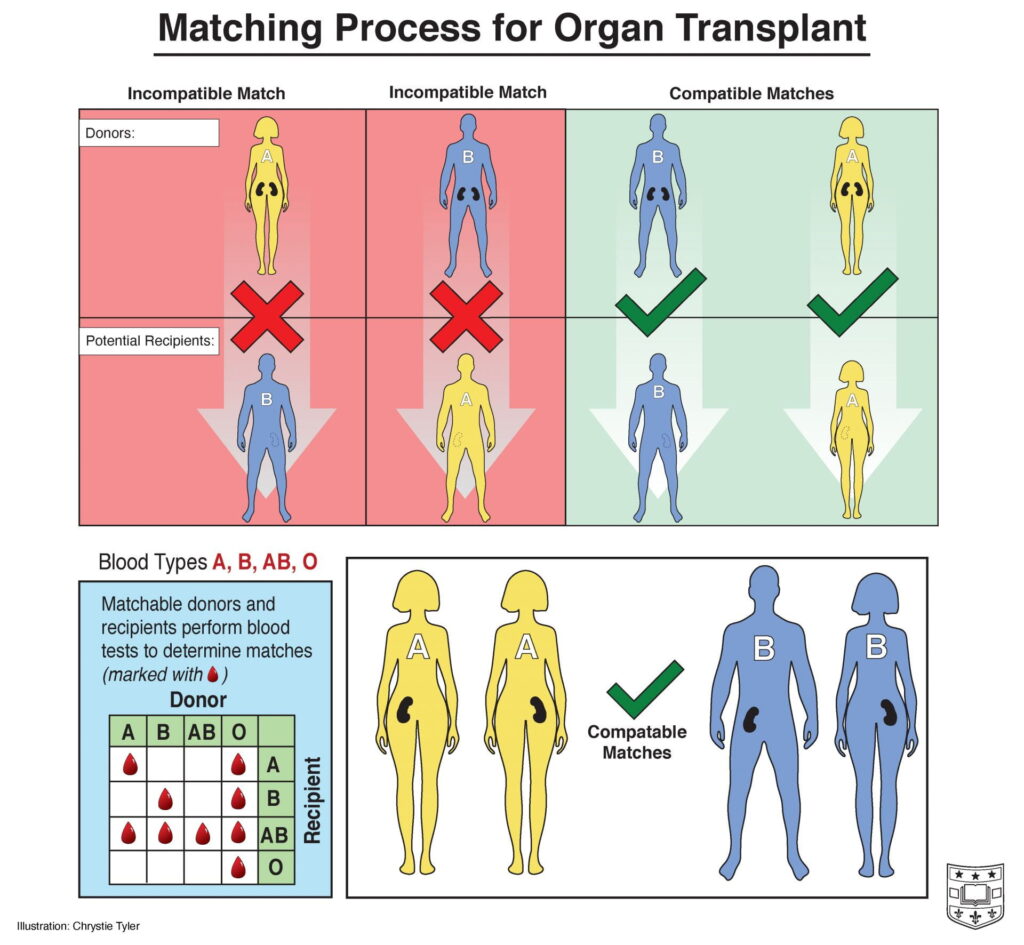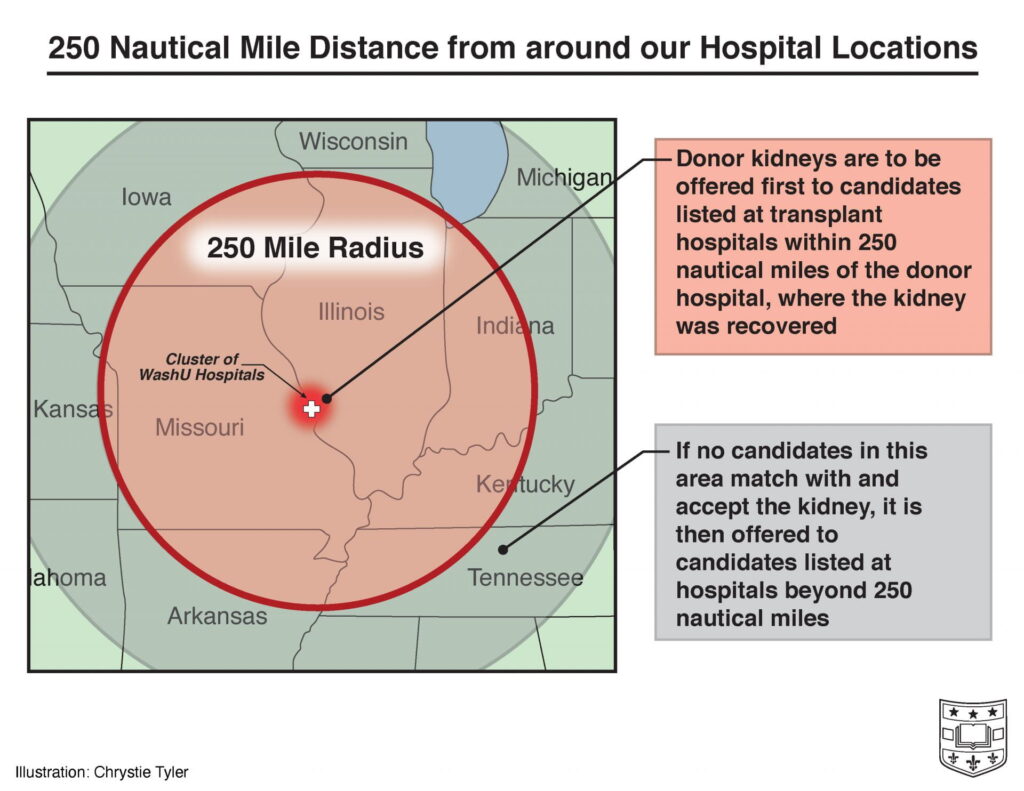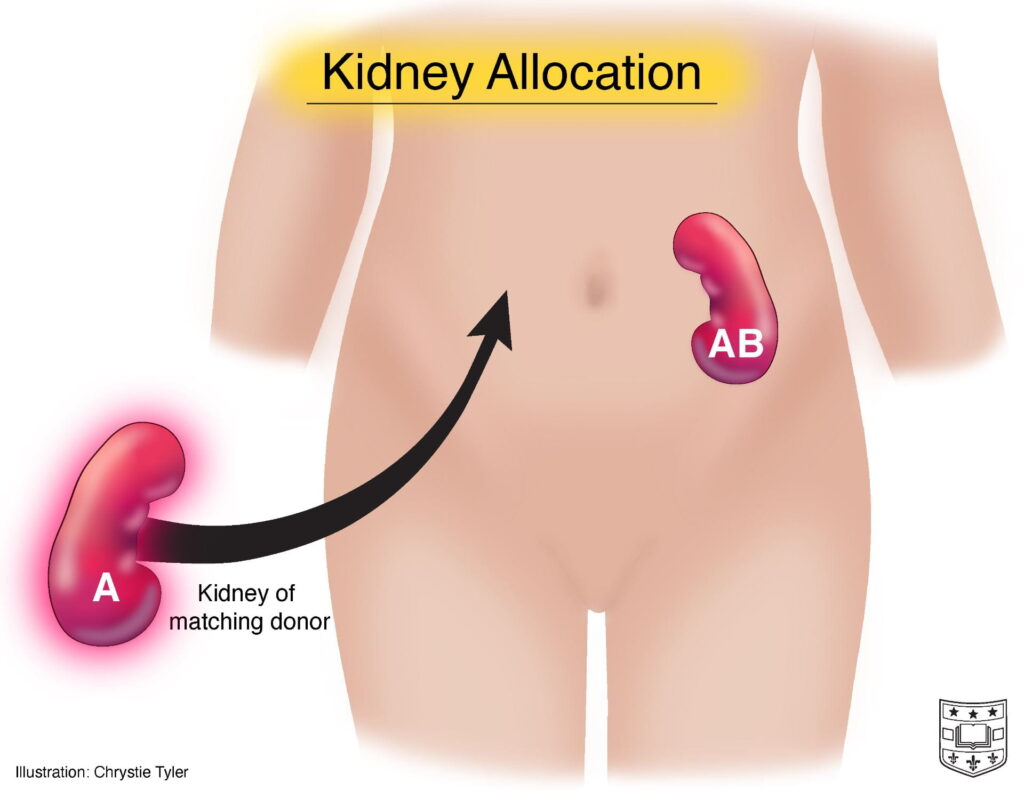Kidneys are an essential organ and the most common organ to be transplanted in the United States. Recent policy change in March 2021 has amended kidney allocation, the process of matching donor organs to patients. Previously, allocation was based on the region or area in which the responsible transplant organization operated. A “donation service area” determined which patients would be offered kidneys within the same organizational jurisdiction. With this policy change, relative distance now determines which patients will be the first candidates to be offered a donor kidney. This amendment is projected to increase equity in the access of waiting recipients nationwide.
On this page:
Kidney Allocation and New Guidelines Explained
What is kidney allocation?
Kidney allocation is the process by which organ donors who can offer functional kidneys are matched to patients in need of these organs. This system is regulated by national networks for assessing, matching and transplanting organs from donors to recipients. The United Network for Organ Sharing (UNOS) directs the system for matching kidney transplant candidates to donors and their allocated kidneys.
What does it mean to be a donor whose organs are allocated? What does it mean to be a recipient?
Organ donors whose kidneys are “allocated” are usually people who have recently passed away due to causes that don’t affect the integrity or function of their kidneys. They or their families will choose to initiate the donation process. Overall health is assessed to determine what organs the donor may offer. If a kidney is approved, this donation is then matched to recipients. These patients are in need of a replacement for a kidney that is not functioning correctly, thus severely compromising their health. Matching kidneys requires rigorous testing to ensure that the recipient will not “reject” the donor organ. Rejection may occur due to differences in proteins that cause the recipient’s immune system to attack the foreign tissue of the transplanted kidney.
In rarer cases, a living donor may elect to donate a kidney without knowing a recipient, and these kidneys also go through the allocation process to find a matchable recipient.

How is the allocation process different from that of living donor kidney transplant?
Allocation works differently than the typical living donor kidney transplant, in which a kidney is usually given to a patient by someone they know. The living donor must have two functioning kidneys and be a match to the recipient. Although they are a more likely match, a living donor does not need to be a biological family member – it can be a friend or colleague.
How has kidney allocation worked in the past?
Before 2021, kidney allocation was directed by an organization-based distribution policy. The policy dictated that the donation service area (DSA) and the Organ Procurement and Transplantation Network (OPTN) would determine which patients were candidates to receive a kidney. This means the donated kidney would first be screened as a match to people within the immediate DSA or OPTN region. In this system, the recipients first offered an available kidney were chosen based on the organization that procured the donor organ. These organizations have different designated areas under their jurisdiction for recovery and transplant. Regions are not evenly distributed or equally sized, making allocation less optimized in some areas.
What do the new guidelines mean?
Effective as of March 15, 2021, the UNOS and OPTN policy states that donor kidneys are to be offered first to candidates listed at transplant hospitals within 250 nautical miles of the donor hospital, where the kidney was recovered. If no candidates in this area match with and accept the kidney, it is then offered to candidates listed at hospitals beyond 250 nautical miles. Recipient candidates are scored on their proximity to the donor hospital, so the point assignment will be highest for those closest to the available kidney. If a donor kidney is considered a perfect match for someone on the national recipient list, it is offered to that person no matter their distance from the donor hospital.
How was the new policy developed?
The policy change was drafted during a period of three years. Organ donation and transplant experts, organ recipients and donor families nationwide contributed to its development. Further input was taken from thousands of public citizens during three comment cycles before the final policy was announced and implemented.
Why are these changes important? Who does this benefit?
This change in allocation process follows the same changes in all other organ allocation systems (i.e. those for liver, heart, lungs, etc.), leading to a unanimously distance-based approach. The new kidney allocation policy is projected to increase equity in transplant access for candidates nationwide. It prioritizes medical need, optimized timing and recipient suitability rather than geography or organizational jurisdiction.
This change could benefit patients awaiting kidney transplant, because it increases the transplant access for patients who may otherwise not be in the organizational-based range of matchable donor kidneys. The Scientific Registry of Transplant Recipients conducted statistical simulation modeling to project how recipients will benefit. Their modeling indicated that often neglected groups, such as children, women, ethnic minorities and difficult-to-match candidates, will have improved transplant access.
How will this have an impact on patients in the St. Louis region and Missouri residents?
Policy change will impact both donors and recipients in the St. Louis region and Missouri more broadly. Rather than being assessed based on DSA and OPTN regional systems, the allocation process is now based on distance between donor and recipient. This change increases the potential for matches between nearby donors and recipients that are not in the same organizational region.

What should I do if I have been told I need a kidney transplant?
As someone awaiting a donor kidney, a potential recipient should closely monitor their health to ensure they will be a ready candidate for transplant when a kidney becomes available. Patients in need of a transplant are often suffering from kidney failure and will undergo dialysis treatments and dietary restrictions to prevent further health complications.
A recipient will also be in close contact with their physician to be informed when a donor kidney is offered to them. Potential recipients are kept on national lists to coordinate their availability for readily transplanted kidneys, but wait times on these lists vary widely and can even be several years. This distance-based policy change, among other developments in transplant services, has the potential to reduce such extensive wait times.
Where can I learn more about kidney allocation?
The Organ Procurement and Transplantation Network Kidney and Pancreas Transplantation Committees hosted a webinar in November 2020 to explain this policy change and its benefits to those affected. It provides valuable context and expertly-described information about this amendment.
Other resources on the Washington University of St. Louis School of Medicine website explain more about the kidney transplant process.
Washington University Transplant Surgery
Washington University Transplant Surgery draws upon a long, successful history as it offers the latest advancements in the transplant field. The kidney transplant team at the Washington University and Barnes-Jewish Transplant Center performs more than 250 kidney transplants per year. Surgeons are members of a multidisciplinary team that provides comprehensive care from initial testing and evaluation to long-term follow-up care after transplant surgery. Washington University transplant surgeons are also leaders in innovative techniques, cutting-edge research and multi-organ transplant.
Learn more about the Transplant team and surgical program at transplantsurgery.wustl.edu.
To contact a transplant physician at the Center for Advanced Medicine or St. Louis Children’s Hospital, please call 314-362-7792.
